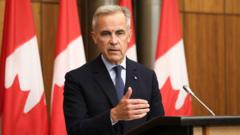In an unprecedented heat wave, Toronto is feeling the brunt of soaring temperatures that haven't been experienced in nearly a decade, mirroring severe conditions in parts of the northeastern United States. With temperatures reaching a staggering 36 degrees Celsius (97 degrees Fahrenheit) on Monday and expected to continue with little relief, many residents have been compelled to stay indoors, desperately seeking the comfort of air conditioning.
The rising heat has led authorities to temporarily close several public schools, as the extreme conditions could threaten the safety of lifeguards, which sparked frustration among parents and students alike. According to Environment Canada, which maintains meteorological records, such high temperatures have not been seen since July 13, 2016. The high humidity further exacerbates the discomfort, making it challenging for individuals to regulate their body temperatures.
Local health officials have issued warnings urging individuals to remain indoors, stay hydrated, and be alert to symptoms of heat exhaustion such as nausea and fatigue. "High humidity makes it far more difficult for the body to cool down effectively," affirmed Steven Flisfeder, a meteorologist with Environment Canada.
The impact of this intense heat wave has also led to the sporadic shutting down of public swimming pools—much to the dismay of families hoping to cool off during the height of summer. Toronto’s Mayor Olivia Chow expressed her disappointment over the sudden closures, which resulted from labor regulations designed to protect workers in extreme heat. "This cannot happen again," she stated, promising to address the staffing shortages by increasing the number of lifeguards and enhancing shaded areas.
Given that the school year is approaching its end, the Toronto District School Board communicated with parents in advance, advising them to prepare students for the challenging conditions. Notably, only about 30 percent of the board’s 579 schools have air conditioning, which poses a significant challenge in combating heat-related issues in educational settings. This contrasts sharply with the 90 percent of households in the United States fitted with similar cooling systems.
Other cities across southern Ontario and Quebec, such as Ottawa and Montreal, are also grappling with similar stifling heat. As residents hold out hope for cooler weather, forecasters predict a brief respite with temperatures expected to normalize later in the week. The unprecedented heat wave continues to remind us of the profound impacts of climate change and the urgent need for communities to adapt to these extreme weather conditions.
The rising heat has led authorities to temporarily close several public schools, as the extreme conditions could threaten the safety of lifeguards, which sparked frustration among parents and students alike. According to Environment Canada, which maintains meteorological records, such high temperatures have not been seen since July 13, 2016. The high humidity further exacerbates the discomfort, making it challenging for individuals to regulate their body temperatures.
Local health officials have issued warnings urging individuals to remain indoors, stay hydrated, and be alert to symptoms of heat exhaustion such as nausea and fatigue. "High humidity makes it far more difficult for the body to cool down effectively," affirmed Steven Flisfeder, a meteorologist with Environment Canada.
The impact of this intense heat wave has also led to the sporadic shutting down of public swimming pools—much to the dismay of families hoping to cool off during the height of summer. Toronto’s Mayor Olivia Chow expressed her disappointment over the sudden closures, which resulted from labor regulations designed to protect workers in extreme heat. "This cannot happen again," she stated, promising to address the staffing shortages by increasing the number of lifeguards and enhancing shaded areas.
Given that the school year is approaching its end, the Toronto District School Board communicated with parents in advance, advising them to prepare students for the challenging conditions. Notably, only about 30 percent of the board’s 579 schools have air conditioning, which poses a significant challenge in combating heat-related issues in educational settings. This contrasts sharply with the 90 percent of households in the United States fitted with similar cooling systems.
Other cities across southern Ontario and Quebec, such as Ottawa and Montreal, are also grappling with similar stifling heat. As residents hold out hope for cooler weather, forecasters predict a brief respite with temperatures expected to normalize later in the week. The unprecedented heat wave continues to remind us of the profound impacts of climate change and the urgent need for communities to adapt to these extreme weather conditions.




















